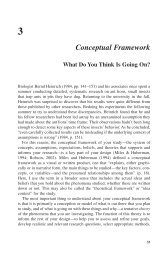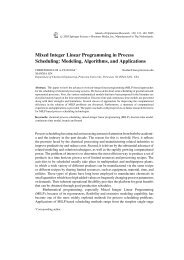Qualitative Research Basics: A Guide for Engineering Educators
Qualitative Research Basics: A Guide for Engineering Educators
Qualitative Research Basics: A Guide for Engineering Educators
You also want an ePaper? Increase the reach of your titles
YUMPU automatically turns print PDFs into web optimized ePapers that Google loves.
• ethnography<br />
• narrative analysis<br />
• critical research<br />
• postmodern research<br />
Denzin and Lincoln (2005) list the following eight research strategies:<br />
• case study<br />
• ethnography/participant observation/per<strong>for</strong>mance ethnography<br />
• phenomenology/ethnomethodology<br />
• grounded theory<br />
• life history<br />
• historical method<br />
• action and applied research<br />
• clinical research<br />
As these lists show, not all research strategies reflect the same aspect of the research<br />
design. Phenomenology is a theoretical perspective that also has important elements of<br />
data analysis, grounded theory is primarily a data analysis method, and case study refers<br />
to the bounds of sampling. Merriam (2002) notes this, pointing out that case study<br />
research can be approached as an ethnography or used to develop a grounded theory (p.<br />
8). Six research strategies are highlighted here: ethnography, phenomenology, grounded<br />
theory, case study, narrative analysis, and basic interpretive research.<br />
Ethnography<br />
An ethnography is a description and interpretation of the cultural behavior of a group. By<br />
culture is meant the behaviors, language, and social practices that define the unique<br />
aspects of that group. While one might typically think of a culture as referring to ethnicity<br />
or religion, any group, such as an institution or organization, can be considered to have its<br />
own culture. Observation of a culture can be used to understand the meaning of the<br />
behavior that occurs within that group.<br />
An ethnography involves in-depth immersion by the researcher in the culture being<br />
studied. The researcher is often called a “participant-observer” in that the researcher<br />
becomes, as much as possible, a member of the group while at the same time collecting<br />
data. Data collection techniques involve interviews, collection of documents and other<br />
artifacts, and observations. Ethnographers often record their observations in a field<br />
notebook, where they can also record their personal thoughts and impressions. Analysis<br />
of the data involves both creating a description of the group’s behavior as well as analysis<br />
of what that behavior means.<br />
In some cases a study is called an “ethnography” if it involves any kind of participant<br />
observation. However, to truly be an ethnography it needs to contain the six features<br />
identified by Punch (1998):<br />
• The behavior of the group is understood by understanding the culturally shared<br />
meanings within the group.<br />
10
















